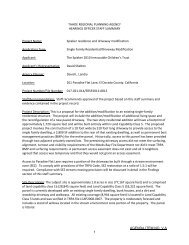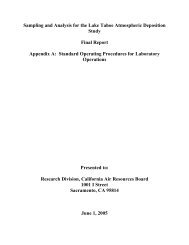FEIS - Tahoe Regional Planning Agency
FEIS - Tahoe Regional Planning Agency
FEIS - Tahoe Regional Planning Agency
You also want an ePaper? Increase the reach of your titles
YUMPU automatically turns print PDFs into web optimized ePapers that Google loves.
RESPONSE TO COMMENTS ON THE DEIS<br />
B o u l d e r B a y C o m m u n i t y E n h a n c e m e n t P r o g r a m P r o j e c t E I S<br />
(adjusted based on 2006 operating conditions), and the Alternatives. The Baseline Existing Conditions<br />
adjusted to 2006 assumes a permanent reduction due to tribal gaming of approximately 32%. The ITE<br />
Daily Trip Generation Estimates for Alternatives A, B, C, D, and E assumes that the permanent reduction<br />
due to tribal gaming is eliminated for all future conditions (e.g., the numbers represent a worst case<br />
assumption for gaming).<br />
Table 8.5-2<br />
Trip Generation Summary including Alternative Baseline<br />
Scenario Daily Trip Generation PM Peak<br />
Existing Conditions (based on 2008<br />
Traffic Counts)<br />
Alternative Baseline Existing<br />
Conditions (adjusted to 2006)<br />
2,846 234<br />
3,849 315<br />
Alternative A 5,853 373<br />
Alternative B 7,870 504<br />
Alternative C 3,501 274<br />
Alternative D 3,948 302<br />
Alternative E 8,468 554<br />
Source: Fehr & Peers, 2010<br />
Please refer to the Boulder Bay Alternative Baseline Existing Conditions Traffic Volumes (Fehr & Peers,<br />
2010) in Appendix AA of the <strong>FEIS</strong> for additional information on the methodology for calculating the<br />
alternative baseline existing condition.<br />
As shown in Table 8.5-2, using the results of the alternative baseline conditions analysis, the Proposed<br />
Project (Alternative C) generates more traffic than the 2008 counts, but less daily traffic than the<br />
alternative baseline conditions. Alternatives C and D also generate less PM peak hour traffic than the<br />
alternative baseline existing conditions. The alternative baseline existing conditions traffic analysis<br />
supports the conclusions included in the DEIS that Alternative C would not increase vehicle trips.<br />
Master Response 3 – Internal/External Alternative Mode Trips, Fehr & Peers Mixed Use<br />
Development Model<br />
Comment Summary – The EIS should explain why Alternatives C and A have different internal trip<br />
capture rates. The Fehr & Peers mixed-use development trip generation model is inaccurate because it<br />
does not include interval-ownership or hotels, it fails to consider external trips by guests to recreation,<br />
retail, and services beyond the Project Area, and trips were double counted when “Alternative Mode<br />
Split” factors were applied to the total number of “raw” trips, rather than only to external trips. Trip<br />
reduction estimates based on the shuttle service are overly optimistic.<br />
PAGE 8- 18 HAUGE BRUECK ASSOCIATES SEPTEMBER 8 , 2010






